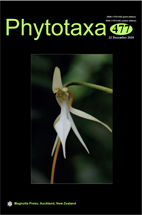Abstract
Cissus Linnaeus (1753: 117) is the most speciose genus in the family Vitaceae and notable for its pantropical intercontinental disjunct pattern (Liu et al. 2013). According to the recent estimate, the genus is known to have 291 accepted species (POWO 2020) and it is widely distributed in tropical regions of Africa, Asia, Australia, Central and South America and Mexico (Wen 2007). The main characters delimiting Cissus from other Vitaceae genera are the well-developed, thick and undivided floral disks, tetramerous flowers, one-seeded berries, and seeds with a long and linear chalaza (Wen 2007). In South America, Cissus is represented by 64 species (Lombardi 2000, 2007, Rodrigues et al. 2014). Amongst C. ulmifolia (Baker 1871: 213) Planchon (1887: 552) that is a later homonym of an Italian fossil taxon Cissus ulmifolia Massalongo (1858: 80). While checking the literature and relevant websites for the availability of any synonyms, we found that C. allenii Croat (1977: 358) and C. serrulatifolia Williams (1962: 375) are listed as heterotypic synonyms of C. ulmifolia in Tropicos (2020) following Nelson (2010). However, C. allenii was synonymized under C. serrulatifolia by most of the workers (Govaerts 1999, Lombardi 2007, Morales 2015, POWO 2020, Raz & Zamora 2020) but C. ulmifolia was treated as a distinct species. So in order to ascertain the taxonomic status, we critically studied the protologues and digital specimens including types of these three species, we found that the characters of C. allenii are well within the range of C. serrulatifolia but C. ulmifolia differs from them by its 4-sided, distinctly winged stem (vs. stem terete, not winged or wingless in C. serrulatifolia) and the fruits ovoid or ovoid–subglobose, smooth (vs. obovoid or subpyriform, lenticellate in C. serrulatifolia). Since no other validly published legitimate name is available for this species (Lombardi 2007, Mota de Oliveira & Jansen-Jacobs 2016, POWO 2020), therefore, the authors propose Cissus lombardiana as a replacement name.
References
Croat, T.B. (1977) Notes on Central and South American Cissus (Vitaceae). Annals of Missouri Botanical Garden 63: 358–362.
<a href="https://doi.org/10.2307/2395315">https://doi.org/10.2307/2395315</a>
Funk, V.A., Hollowell, T.H., Berry, P.E., Kelloff, C.L. & Alexander, S. (2007) Checklist of the plants of the Guiana Shield (Venezuela: Amazonas, Bolivar, Delta Amacuro; Guyana, Surinam, French Guiana). Contributions to the United States National Herbarium 55: 1–584.
Govaerts, R. (1999) World Checklist of Seed Plants 3(1, 2a & 2b), MIM, Deurne, 1532 pp.
Linnaeus, C. (1753) Species plantarum 1. Impensis Laurentii Salvii, Stockholm, 560 pp.
Liu, X., Ickert-Bond, S.M., Chen, L. & Wen, J. (2013) Molecular phylogeny of Cissus L. of Vitaceae (the grape family) and evolution of its pantropical intercontinental disjunctions. Molecular Phylogenetics and Evolution 66: 43–53.
<a href="https://doi.org/10.1016/j.ympev.2012.09.003">https://doi.org/10.1016/j.ympev.2012.09.003</a>
Lombardi, J.A. (1995) Typification of names of South American Cissus (Vitaceae). Taxon 44: 193–206.
<a href="https://doi.org/10.2307/1222442">https://doi.org/10.2307/1222442</a>
Lombardi, J.A. (2000) Vitaceae – Gêneros Ampelocissus, Ampelopsis, e Cissus. Flora Neotropica Monograph 80: 1–250.
Lombardi, J.A. (2007) Systematics of Vitaceae in South America. Canadian Journal of Botany 85: 712–721.
<a href="https://doi.org/10.1139/B07-021">https://doi.org/10.1139/B07-021</a>
Massalongo, A.B. (1858) Synopsis florae fossilis senogalliensis. Merlo, Verona, 139 pp.
<a href="https://doi.org/10.5962/bhl.title.7733">https://doi.org/10.5962/bhl.title.7733</a>
Morales, J.F. (2015) Vitaceae. In: Hammel, B.E., Grayum, M.H., Herrera, C. & Zamora, N. (Eds.) (2015). Manual de Plantas de Costa Rica. Volumen VIII. Dicotyledóneas (Sabiaceae-Zygophyllaceae). Monographs in Systematic Botany from the Missouri Botanical Garden 131: 1–657.
Mota de Oliveira, S. & Jansen-Jacobs, M.J. (2016) Flora of the Guianas, Series A 31, The Trustees of the Royal Botanic Gardens, Kew, 169 pp.
Nelson, C.H. (2010) Adiciones y Comentarios a la Flora de Honduras. Ceiba 51: 70–88.
<a href="https://doi.org/10.5377/ceiba.v51i2.1105">https://doi.org/10.5377/ceiba.v51i2.1105</a>
Planchon, J.E. (1887) Monographie des Ampélidées vraies. In: Candolle, A.L.P.P. de & Candolle, C. de (Eds.) Monographie Phanerogamarum 5. G. Masson, Paris, pp. 305–654.
POWO (2020) Cissus. Available from: <a href="http://powo.science.kew.org/taxon/urn:lsid:ipni.org:names:325875-2">http://powo.science.kew.org/taxon/urn:lsid:ipni.org:names:325875-2</a> (accessed 29 September 2020)
Raz, L. & Zamora, H.A. (2020) Catálogo de Plantas y Líquenes de Colombia. Version 1.1. Universidad Nacional de Colombia. Checklist dataset.
<a href="https://doi.org/10.15472/7avdhn">https://doi.org/10.15472/7avdhn</a>
Rodrigues, J.G., Lombardi, J.A. & Lovato, M.B. (2014) Phylogeny of Cissus (Vitaceae) focusing on South American species. Taxon 63: 287–298.
<a href="https://doi.org/10.12705/632.33">https://doi.org/10.12705/632.33</a>
Tropicos (2020) Cissus. Available from: <a href="http://www.tropicos.org">http://www.tropicos.org</a> (accessed 18 November 2020)
Wen, J. (2007) Vitaceae. In: Kubitzki, K. (Ed.) The families and genera of vascular plants, 9. Springer-Verlag, Berlin, pp. 467–479.
<a href="https://doi.org/10.1007/978-3-540-32219-1_54">https://doi.org/10.1007/978-3-540-32219-1_54</a>
Williams, L.O. (1962) Tropical American plants, III. Fieldiana, Botany 29: 375–389.

